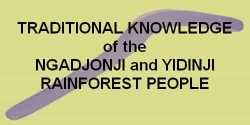Ngadjon Language Resource
Ngadjon Language Resource
Ngadjon vocabulary is small as is common a hunter-gatherer cultures. A great deal is communicated non-verbally. Maintaining silence in the rainforest is essential both in terms of hunting and opportunistic acquisition of protein while gathering food.
- communication during hunting may be via subtle almost imperceptible motions of the eye, a tiny nod of the head, tiny movement of the fingers... that delivers information on hunting strategies... location, number and size of prey...which way to move, when to move, who is to use their weapon, allocation of various roles
- in the jungle trails are marked and information provided via bent ferns or twigs, blazes, materials laid out on a track, deliberate placing of footprints ... to indicate when a person passed, how long ago , how many in the party, which way they were going, whether they were travelling light or carrying burdens ... footprints are like fingerprints to hunter gatherers ... individuals people can be identified ... the genders and ages of hunted game are reflected in their footprints and droppings
- objects placed in places they would not normally be can send messages ... some moss sitting on the fork of a bush...
- in the rainforest sight is diminished .. when you see a moving leaf the creature has often already moved on
- in the rainforest sound predominates ... to the trained ear each creature produces a distinctive sound when moving
- in the rainforest smell travels further than sight or sound ... the distinct smell or a particular ripe fruit... the fishy / meaty smell of a python or the smell of a particular type of possum in a tree
- the presence of bio-indicators communicate actions that need to be taken (for example the singing of green cicadas may initiate the harvest of bush turkey eggs)
- some courses of action requiring complex interaction are ancient and traditional.. there is no need to say "lets go hunting.. you do this and I'll do that"

 twigs
twigs 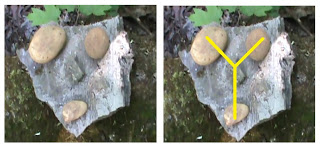
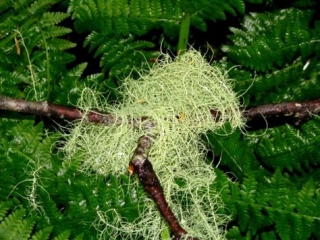 objects
objects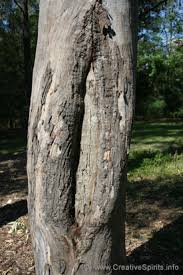
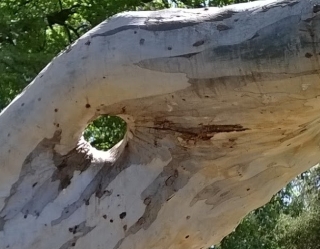 markers
markers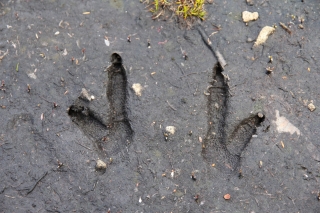

Spreadsheet of all 1981 Ngadjon Words and Sources
(download and open in spreadsheet progam)
2022 - Now includes some verbs .xls format .csv format
Spreadsheets as of April 2022 shows 1981 words plus 309 loan
words Ngadjon – English Glossary
- 1421 wordsEnglish – Ngadjon Glossary
-1421 wordsA Guide to the Sounds in Ngadjon
An appeal for Open Source
Language by Category...(links open in a new window)
Animals Ngadjon – English
Birds - Ngadjon – English
Ceremony and Tradition - Ngadjon
– English
Family - Ngadjon – English
Fish - Ngadjon – English
Insects and Small Creatures -
Ngadjon – English
Land and Water - Ngadjon –
English
Loan Words - Ngadjon – English
Parts of Body - Ngadjon –
English
People - Ngadjon – English
Plants – Trees - Ngadjon –
English
Plants – Other - Ngadjon –
English
Reptiles and
Amphibians - Ngadjon – English
Sounds - Ngadjon – English
Things We Use - Ngadjon –
English
Time - Ngadjon – English
Weather and Sky - Ngadjon –
English
Additional words
and Place Names
Tribal and Language Name and Associations...
It should be noted that where verbs are listed, only one form is shown in
the list.Speakers of the language will be familiar with other forms.
Likewise, speakers will be aware of gender markers (bayi, balan, balam, bala) which are not shown in the list.
We would welcome a listing of more verbs but currently those that we are aware of are behind a university/ publisher paywall.
You don't have to pay to use English.
Some university students may have access to these resources
A Guide to the Sounds in Ngadjon
Note:It is essential to refer to local language speakers for accurate pronunciation of specific words and phrases. Several guides are provided dating at different times...Professor Bob Dixon pioneered linguistic studies amongst Aboriginal people in North Queensland and in writing this glossary I have tried to adhere to his basic outlines for writing dialects of the Dyribal language group.
I will quote him briefly here, however anyone seriously interested in studying Ngadjon language is well advised to go to the source.
Special note on b and p - Dixon's scheme uses b to cover both these sounds since there are no word pairs (such as bat and pat in English) that would require the distinction. However, contemporary Ngadjon uses a distinct p sound for some words. Where this is the case, we have used p in this list. - M.H.
| Letter | English sound as in... | Ngadjon word |
|---|---|---|
| a | above | mala |
| aa | path | daaru |
| i | sick | bigin |
| ii | yield | jiinji |
| u | put | gugu |
| uu | poor | duugu |
| b | bat | buni |
| d | desk | dandu |
| g | good | gagu |
| j | jam | jawa |
| l | lolly | galbu |
| m | mum | midin |
| n | no | nigu |
| ng | sing | ngagi |
| ny | o |
nyamu, marrginy |
| r | rag | ruguju |
| rr | Rolled “rr as in Scottish | Robert the Bruce |
| |
water | wana |
| y | yellow | yabun |
"There are thirteen consonants - b,d,g,j,l,m,n,ny,ng,r,rr,w,y.
- b and m are sounds pronounced with the lips, exactly like b and m in English.
- d and n are also quite like English sounds; they are pronounced with the tip of the tongue just touching the ridge just behind the top teeth.
- j and ny are rather different from any sounds that occur in English. The sound we write j for is like a d and a y pronounced at the same time ... ny is like n and y pronounced at the same time. These sounds are pronounced with the front part of the tongue against the front part of the roof of the mouth, with the tip of the tongue just behind the teeth.
- g is exactly like the English sound and ng is like the sound that occurs at the end of some words in English (as in 'bang' and 'sing'). These are made by the back of the tongue being pressed against the back part of the roof of the mouth.
- i - the front of the tongue raised up towards the roof of the mouth. This usually sounds like the vowel in the English word 'beet' but it can sound like the vowel in 'bit' or even that in 'bet' ...
- u - the back of the tongue is raised towards the roof of the mouth. This usually sounds like the vowel in English 'boot' or 'tool' but it can sound like the vowel in 'put' or enen that in 'bought' ...
- a - with the mouth quite open and the tongue lying in the bottom of the mouth. This is like the sound in English 'bat' and 'man', but it can be pronounced like the vowel in 'half' or even that in 'not' ..."
More from Dixon (1984 Memoirs) on pronunciation of Dyribal words...
ng is a single sound; it occurs only at the end of a syllable in English - the single sound after the vowel in sing for instance.
One way of learning how to say a word like nga "yes" (in Dyribal) is to begin with sing, add an a , and on repetition drop off the si-, thus singa. singa, nga. Unlike in the English word finger, there is no hard g sound as in nga
ny is a single sound, like an n and y pronounced simultaneously; it is like the sound in the middle of English onion (and is identical to the Spanish ñ)
j is like d and y pronounced simultaneously; a sharper sound than that in English words like judge
rr is trilled or rolled r as in Scottish pronumciation
r is very close to the Australian or English pronunciation as in arrow
b,d,g,m,n,l,y and w can be pronounced almost exactly as in English
i is pronounced like the vowel in English bit
u is pronounced like the vowel in English took
a is pronounced like the vowel in English ban
Doubling of a vowel letter indicated a lengthened vowel...
ii is like the vowel in beat only longer
uu is like that in soup only longer
aa is like the vowel in southern English pronunciations of grass, only longer
Each vowel should be pronounced carefully and distinctly; they should never be reduced to the vowel sound of the English the, for instance
Dyirbal
Dyirbal (also Djirubal) is a tonal and ergative Australian Aboriginal language spoken in northeast Queensland by about 5 speakers. It possesses many outstanding features that have made it well known among linguists.The Ngadgon people classify nouns in a unique manner which has made linguists need to re-think ways in which language can be organised.
Phonology
Dyirbal actually has only four places of articulation for the stop and nasal consonants—this is fewer than most other Australian Aboriginal languages, which have six. This is because Dyirbal lacks the dental/alveolar split typically found in these languages. It also lacks voiceless consonants, an extremely uncommon trait among languages. Its vowel system is similarly small, with only three vowels: /i/, /a/ and /u/.
Grammar
The language is best known for its system of noun classes, numbering four in total.
They tend to be divided among the following semantic lines:
I - animate objects, men
II - women, water, fire, violence
III - edible fruit and vegetables
IV - miscellaneous (includes things not classifiable in the first three)
The class usually labeled "feminine" (II), for instance, includes the word for fire and nouns relating to fire, as well as all dangerous creatures and phenomena.
This inspired the title of the George Lakoff book "Women, Fire and Dangerous Things" - an outline of his division of nouns is given below (based on powerpoint presentation slides)
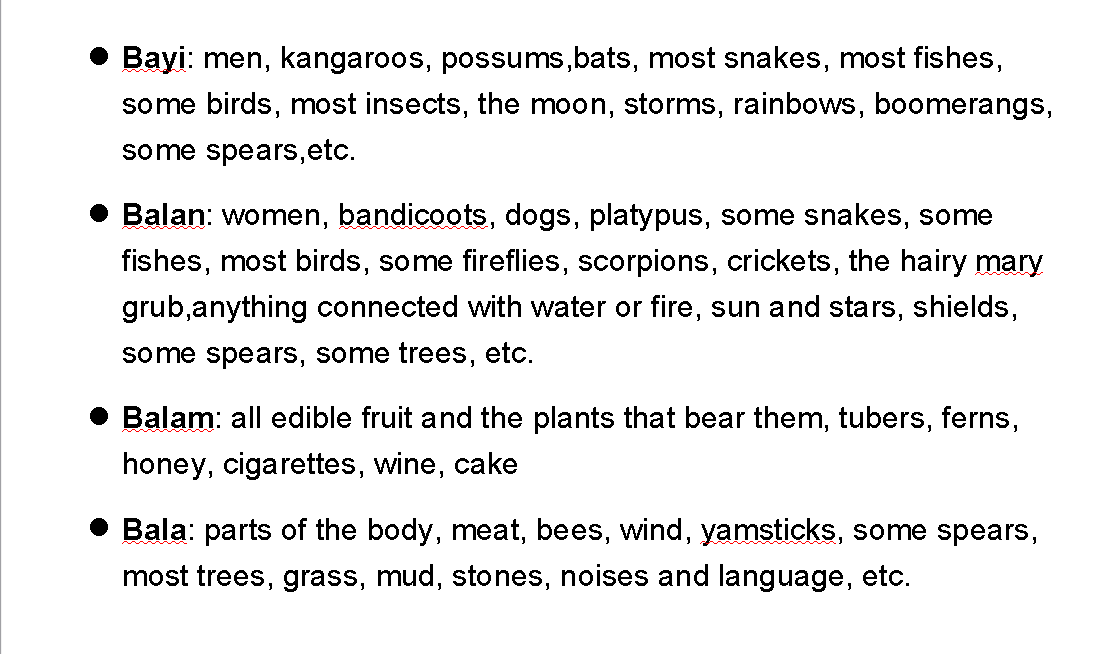
Using Language to Suggest a View of the World
The noun "gender"diagram below may gives some insight into the way the Ngadjonji view the world.
When a Ngadjon person enters their rainforest they enter the "greatest supermarket in the world", no specialising here, everything they will need for their entire lives is to be found here.
They are, simultaneously, of the rainforest, the landscape, the past, present and the future, not necessarily looked at separately, but as a whole.
Males associate directly with hunted food, where to camp, defence, ritual, spiritual
Females associate with interconnectness, daily food and materials, family lines, bio-indicators
In a largely vegetarian society there is a special relationship with the plant world.
Some things durable and enduring supply messages , guidelines , tools...
and everywhere stories link things together.
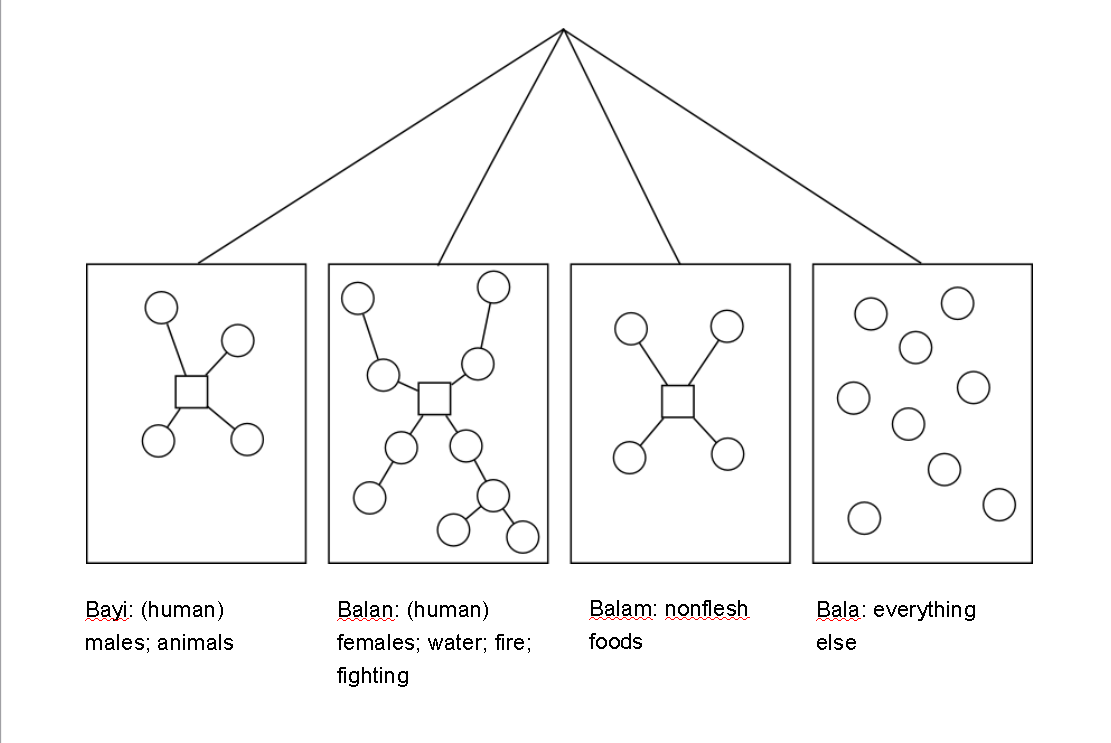
Some linguists distinguish between such systems of classification and the gendered division of items into feminine, masculine, and sometimes neuter found in, for example, many Indo-European languages.
Dyirbal is remarkable because it shows a split-ergative system.
Sentences with a first or second person pronoun have their verb arguments marked for case in a pattern that mimics nominative-accusative languages. That is, the first or second person pronoun appears in the least marked case when it is the subject (regardless of the transitivity of the verb), and in the most marked case when it is the direct object. Thus Dyirbal is morphologically accusative in the first and second persons, but morphologically ergative elsewhere; and it is still always syntactically ergative.
Taboo
There used to be in place a highly complex taboo system in Dyirbal culture. A speaker was completely forbidden from speaking with his/her mother-in-law, child-in-law, father's sister's child or mother's brother's child, and from approaching or looking directly at these people. In addition, a specialized and complex form of the language, with essentially the same phonemes and grammar, but with a lexicon that shared no words with the non-taboo language, was used when within hearing range of taboo relatives. It existed until about 1930 when the taboo system fell out of use.
Tribal and Language Names
(after Dixon 1984 Memoirs with minor addenda)Dialects of Dyirbal
- Girramaygan people speak Girramay
- Jirrbalngan (sometimes called Jirrbalji) speak Jirrbal
- Malanbarra speak Gulngay
- Ngajanji (written Ngadjonji on this website) speak Ngajan (written as Ngadjon on this website)
- Dulgubarra Mamu (usually called Mamu)
- Waribarra Mamu (often called Wari)
- Jirru
- Yidinyji (written on this site as Yidinji), Gungganyji speak Gunggay and also Wanyurr - are dialects of a single language
- Jabuganyji speak Jabugay (written eslewhere as Tjapukai) and Yirrganyji people speak Yirrgay - two dialects of one language
- Warrgamaygan speak Warrgamay; Biyay is another dialect og the same language
- Gugu-Yalanji (written elsewhere as Kuku Yalanji) , Muluriji, Jangan, wagaman are dialects of a single language
- Mbabaram, Warungu, Nyawaygi, Olgolo, Gugu-Mini, Gugu-Daiban, Gugu Yimidhirr, Lama-Lama and the Flinder Island language are all different languages, distinct from each other and from those listed above
An appeal for Open Source
from Universities and Museums: More information is out there but much, often, for no logical reason, is now considered "copyright", "access denied" or hidden behind "paywalls".The Ngadjon should have access. It is their culture. The vast majority of cultural research, taking into account cultural sensibilities, in an enlightened society, should be open source.**)
Knowledge is pointless unless it is shared... Shared knowledge builds bridges of understanding. .. Without understanding reconciliation is no more than a dream
Ngadjon - English Glossary English - Ngadjon Glossary
Animals Birds Ceremony and Tradition Family Fish Insects and Small Creatures
Land and Water Loan Words Parts of Body Plants Other Plants Trees Reptiles and Amphibians
Scientific Names Sounds Things We Use Time Weather and Sky Additional Words and Place Names

